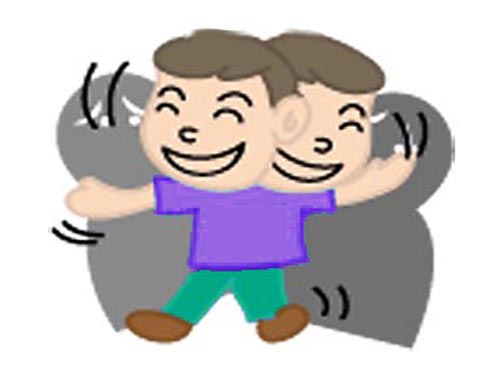Hyperactivity, ADHD

Published: 18 Jun 2025
ICD9: 314.01 ICD10: F90.0 ICD11: 6A05.Z
"Hyperactivity" and "ADHD" (Attention-Deficit/Hyperactivity Disorder) are closely related.
Hyperactivity is a core symptom of ADHD, but it's important to understand the full picture.
Here's a breakdown:
![]() ADHD (Attention-Deficit/Hyperactivity Disorder): ADHD is a neurodevelopmental disorder characterized by persistent patterns of inattention, hyperactivity, and/or impulsivity that interfere with functioning or development. It's not just about being "hyper" or having trouble paying attention; it's a complex condition that affects executive functions in the brain.
ADHD (Attention-Deficit/Hyperactivity Disorder): ADHD is a neurodevelopmental disorder characterized by persistent patterns of inattention, hyperactivity, and/or impulsivity that interfere with functioning or development. It's not just about being "hyper" or having trouble paying attention; it's a complex condition that affects executive functions in the brain.
![]() Hyperactivity: This refers to excessive physical movement and difficulty staying still, even when it's inappropriate to do so. It's one of the three main symptom clusters of ADHD.
Hyperactivity: This refers to excessive physical movement and difficulty staying still, even when it's inappropriate to do so. It's one of the three main symptom clusters of ADHD.![]()

![]() Symptoms of Hyperactivity Often Include:
Symptoms of Hyperactivity Often Include:![]()

![]() Fidgeting and Squirming: Difficulty sitting still, often fidgeting with hands or feet, or squirming in a seat.
Fidgeting and Squirming: Difficulty sitting still, often fidgeting with hands or feet, or squirming in a seat.![]()

![]() Leaving Seat: Getting up and moving around in situations where remaining seated is expected (e.g., in the classroom).
Leaving Seat: Getting up and moving around in situations where remaining seated is expected (e.g., in the classroom).![]()

![]() Running or Climbing: Excessive running or climbing in situations where it is inappropriate. (In adolescents or adults, this may manifest as restlessness.)
Running or Climbing: Excessive running or climbing in situations where it is inappropriate. (In adolescents or adults, this may manifest as restlessness.)![]()

![]() Difficulty Playing Quietly: Trouble engaging in leisure activities or playing quietly.
Difficulty Playing Quietly: Trouble engaging in leisure activities or playing quietly.![]()

![]() Being "On the Go" or "Driven by a Motor": Acting as if "driven by a motor" and being constantly active.
Being "On the Go" or "Driven by a Motor": Acting as if "driven by a motor" and being constantly active.![]()

![]() Talking Excessively: Talking a lot, often interrupting or dominating conversations.
Talking Excessively: Talking a lot, often interrupting or dominating conversations.
![]() Inattention: Another key symptom cluster in ADHD. It includes difficulties with:
Inattention: Another key symptom cluster in ADHD. It includes difficulties with:![]()

![]() Paying close attention to details
Paying close attention to details![]()

![]() Sustaining attention in tasks or play activities
Sustaining attention in tasks or play activities![]()

![]() Listening when spoken to directly
Listening when spoken to directly![]()

![]() Following through on instructions
Following through on instructions![]()

![]() Organizing tasks and activities
Organizing tasks and activities![]()

![]() Avoiding or disliking tasks requiring sustained mental effort
Avoiding or disliking tasks requiring sustained mental effort![]()

![]() Losing things necessary for tasks or activities
Losing things necessary for tasks or activities![]()

![]() Being easily distracted
Being easily distracted![]()

![]() Being forgetful in daily activities
Being forgetful in daily activities
![]() Impulsivity: The third symptom cluster. It involves acting without thinking and can include:
Impulsivity: The third symptom cluster. It involves acting without thinking and can include:![]()

![]() Blurting out answers before questions have been completed
Blurting out answers before questions have been completed![]()

![]() Having difficulty waiting one's turn
Having difficulty waiting one's turn![]()

![]() Interrupting or intruding on others
Interrupting or intruding on others
![]() Types of ADHD:
Types of ADHD:![]()

![]() Predominantly Inattentive Presentation: Primarily characterized by symptoms of inattention. Formerly known as ADD.
Predominantly Inattentive Presentation: Primarily characterized by symptoms of inattention. Formerly known as ADD.![]()

![]() Predominantly Hyperactive-Impulsive Presentation: Primarily characterized by symptoms of hyperactivity and impulsivity.
Predominantly Hyperactive-Impulsive Presentation: Primarily characterized by symptoms of hyperactivity and impulsivity.![]()

![]() Combined Presentation: Characterized by significant symptoms of both inattention and hyperactivity-impulsivity. This is the most common type.
Combined Presentation: Characterized by significant symptoms of both inattention and hyperactivity-impulsivity. This is the most common type.
Important Considerations:
![]() Diagnosis: ADHD is a clinical diagnosis made by a qualified professional (e.g., pediatrician, psychiatrist, psychologist) based on established criteria (DSM-5). It's not just about observing a few hyperactive behaviors.
Diagnosis: ADHD is a clinical diagnosis made by a qualified professional (e.g., pediatrician, psychiatrist, psychologist) based on established criteria (DSM-5). It's not just about observing a few hyperactive behaviors.
![]() Context Matters: The symptoms must be persistent, occur in multiple settings (e.g., home, school, work), and significantly impair functioning.
Context Matters: The symptoms must be persistent, occur in multiple settings (e.g., home, school, work), and significantly impair functioning.
![]() Other Conditions: ADHD can co-occur with other conditions, such as anxiety, depression, learning disabilities, and oppositional defiant disorder (ODD).
Other Conditions: ADHD can co-occur with other conditions, such as anxiety, depression, learning disabilities, and oppositional defiant disorder (ODD).
![]() Treatment: Treatment typically involves a combination of medication (stimulants or non-stimulants), behavioral therapy (e.g., cognitive behavioral therapy, parent training), and educational interventions.
Treatment: Treatment typically involves a combination of medication (stimulants or non-stimulants), behavioral therapy (e.g., cognitive behavioral therapy, parent training), and educational interventions.
![]() Not Just for Kids: While ADHD is often diagnosed in childhood, it can persist into adulthood.
Not Just for Kids: While ADHD is often diagnosed in childhood, it can persist into adulthood.
In summary, hyperactivity is a significant symptom of ADHD, but it's only one piece of the puzzle. ADHD is a complex disorder that affects attention, behavior, and impulsivity, and requires professional evaluation and treatment.
If you suspect that you or someone you know has ADHD, it's crucial to consult with a healthcare professional for an accurate diagnosis and appropriate treatment plan.